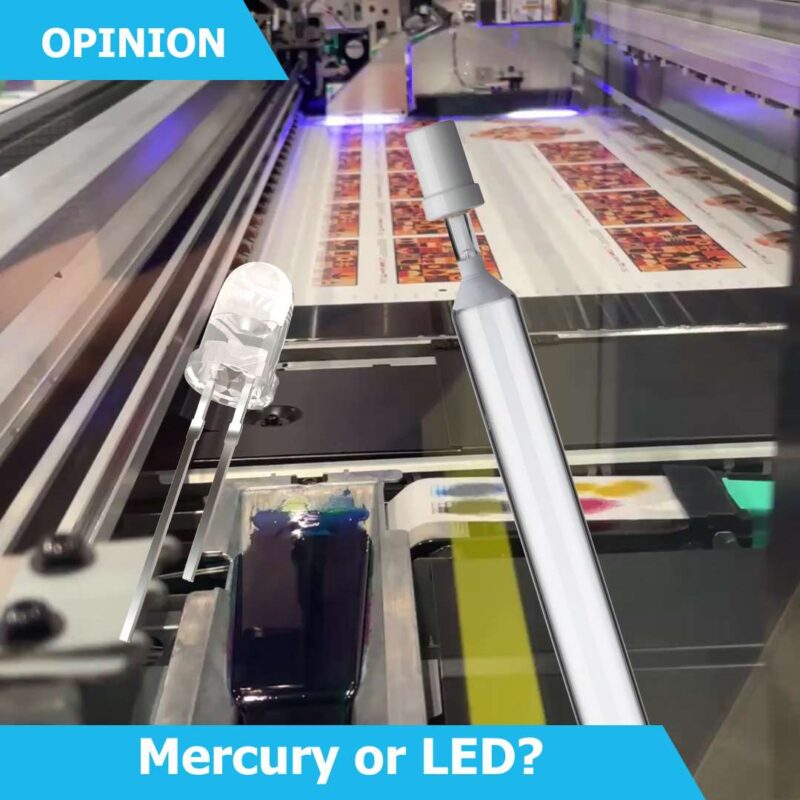In recent years, there’s been plenty of buzz about LED UV curing technology. Trade shows, webinars, even suppliers will tell you: “LED is the future. Mercury is outdated.”
It’s a compelling headline. But it’s not the full picture.
If you’re a print engineer, press operator, or system designer, you know that what looks good on a spec sheet doesn’t always play out the same way on the production floor. The truth is, mercury-based UV curing isn’t just alive, it’s still the backbone of many high-performance applications.
Here’s why.
A Quick History: How We Got Here
UV curing has been a game-changer in printing, coating and bonding. It replaced slower, heat-based drying methods with fast, energy-efficient curing that happens in seconds, using ultraviolet light.
Mercury vapor lamps have been at the core of this process for decades. They emit a broad spectrum of UV wavelengths, which makes them highly versatile for curing a wide range of inks, adhesives, and coatings.
Then came UV LEDs, with claims of being compact, efficient, long-lasting. They emit in a narrow UV range (typically around 385–395 nm) and offer instant on/off, cooler operation, and lower energy use.
It sounds like a perfect upgrade. But…
Mercury vs LED: It’s Not That Simple
 Think of UV curing like baking. Some materials need a long, even bake across multiple temperature zones. Others can be flash-cooked quickly.
Think of UV curing like baking. Some materials need a long, even bake across multiple temperature zones. Others can be flash-cooked quickly.
-
Mercury lamps are the equivalent of a full-spectrum oven. They emit across UVA, UVB, and UVC ranges. That means they work with a broader range of chemistries, including more complex or opaque inks and high-performance adhesives.
-
LEDs are more like a high-efficiency microwave. Great for certain jobs, but limited in scope. Their narrow-band output struggles with some photoinitiators, especially in thicker layers or high-speed environments.
The result? Many industrial applications – especially in wide-web printing, metal decorating, or thick varnishes still rely on mercury UV systems for consistent curing.
Where Mercury UV Still Wins
Even as LED adoption grows, mercury lamps hold the edge in several critical areas:
-
Broad-spectrum output → Works with a wide variety of inks, coatings and adhesives
-
Higher peak irradiance → Enables faster curing on wider and faster lines
-
Legacy compatibility → Integrates with existing press systems and workflows
-
Thermal flexibility → Allows for better cure on heat-resistant substrates
-
Field-proven reliability → Trusted across decades of industrial use
Plus, mercury lamp tech isn’t standing still. Innovations in lamp manufacturing, reflector design, quartz plate coatings, and power supply control are pushing performance, energy efficiency and lifespan further than ever.
The Future: Hybrid Thinking
We’re not in a mercury-vs-LED battle. We’re in a hybrid era.
Savvy operators and OEMs are mixing both technologies based on application needs:
-
Use LEDs for: Short runs, labels, heat-sensitive substrates, narrow-web
-
Use Mercury for: High-speed lines, wide-web curing, complex coatings, deep cure requirements
In many systems, dual-cure formulations and hybrid lamp setups are already the norm, giving engineers the best of both worlds.
Why This Matters for You
If you’re in charge of specifying or maintaining UV curing systems, staying informed isn’t just academic, it impacts:
-
Cure quality
-
System uptime
-
Ink/coating sourcing
-
Energy and maintenance costs
-
Long-term investment strategy
Mercury UV isn’t obsolete. It’s evolving, and it’s still irreplaceable for many industrial-scale jobs.
Bottom Line:
LED is exciting and absolutely has its place.
But mercury UV? Still very much in the game.
Knowing when and where to use each can make or break your next project.
Need help with your UV choices or need to order replacement UV lamps? Contact Us today.
Latest Articles
A Busy Year! Alpha-Cure’s 2025 Year in Review
A Year of Global Reach and Innovation for Alpha-Cure As 2025 draws to a close, we’re reflectin...
View ArticleAvoid Holiday Disruption: Key Order Deadlines for Year End Delivery
As we approach the end of the year, production schedules get tighter and distribution channels come ...
View ArticleAll UV Lamps. One Standard: How Alpha-Cure Scaled UK Excellence Globally
When Alpha-Cure expanded our manufacturing footprint to China, it wasn’t about lowering costs, it ...
View ArticleIndustry Focus – Helping Open New Markets for UV Technology
A guide to support local distributor growth At Alpha-Cure, we’re proud of the strong presence ...
View Article